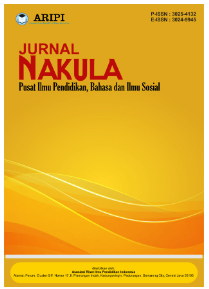Penyimpangan Maksim Kesopanan Dalam Video “Mbambong” Di Youtube Woko Channel
DOI:
https://doi.org/10.61132/nakula.v2i5.1070Keywords:
maxim of politeness, maxim deviation, pragmaticsAbstract
Deviations from the principles of politeness by speech participants are generally due to the desire to achieve a speech. The implicit meaning of speech can have a positive or negative meaning, depending on the context and circumstances when the speech occurs. The purpose of this deviation is, for example, to ridicule, humiliate, show antipathy, and so on, the purpose of which is to harm other people. This research is entitled Deviations from the Maxim of Politeness in the "Mbambong" Video on the Youtube Woko Channel. This research will discuss the forms of deviation from the maxim of politeness in the video "Mbambong" on the Woko Channel YouTube. The aim of this research is to understand the forms of deviation from the maxim of politeness in the "Mbambong" video on the Woko Channel YouTube. This research includes pragmatic studies. The theory used in this research is Leech's maxim of politeness theory because it is considered the most complete of the existing parts of the maxim of politeness. This study used qualitative research methods. Dhata in this research was taken from conversations between paraga in the video "Mbambong" on the Woko Channel YouTube. The source of dhata in this research comes from videos and then transcribed in the form of words and sentences. Based on the results of the research, there are 6 deviations from the maxims in the "Mbambong" video, namely deviations from the maxims: wisdom, generosity, praise, humility, compatibility and sympathy.
Downloads
References
Chaer, A. (2010). Kesantunan berbahasa. Jakarta: Rineka Cipta.
Chaer, A., & Agustina, L. (2004). Sosiolinguistik: Perkenalan awal. Jakarta: Rineka Cipta.
Ermawati, Y., & Adipitoyo, S. (2020, January). Building the character of elementary school students through Javanese language learning. In International Conference on Research and Academic Community Services (ICRACOS 2019) (pp. 157-161). Atlantis Press.
Hymes, D. (1972). Models of the interaction of language and social life. In Gumperz, J. J., & Hymes, D. (Eds.), Directions in sociolinguistics: The ethnography of communication (pp. 35-71). New York: Holt, Rinehart & Winston.
Leech, G. (1983). Prinsip-prinsip pragmatik (M. D. D. Oka, Trans.). Jakarta: Universitas Indonesia (UI Press). (Original work published 1983)
Mansyur, U. (2016). Bahasa Indonesia dalam belitan media sosial: Dari cabe-cabean hingga tafsir Al-Maidah 51. In Prosiding Seminar Nasional & Dialog Kebangsaan dalam Rangka Bulan Bahasa 2016 (pp. 145-155). Fakultas Ilmu Budaya Universitas Hasanuddin. https://doi.org/10.31227/osf.io/7vpjh
Nadar, F. X. (2009). Pragmatik dan penelitian pragmatik. Yogyakarta: Graha Ilmu.
Rahardi, K. (2013). Pragmatik, kesantunan imperatif bahasa Indonesia. Jakarta: Penerbit Erlangga.
Rohmadi, M. (2010). Pragmatik: Teori dan analisis. Surakarta: Yuma Pustaka.
Strauss, A., & Corbin, J. (2007). Dasar-dasar penelitian kualitatif (C. Yuliet, Trans.). Yogyakarta: Pustaka Pelajar.
Surana. (2022). The pragmatics of Javanese people: Pride, identity, and living capital in a digital era. EJAL.
Yule, G. (2006). Pragmatik (I. F. Wahyuni, Trans.). Yogyakarta: Pustaka Pelajar. (Original work published 1996)
Downloads
Published
How to Cite
Issue
Section
License
Copyright (c) 2024 Jurnal Nakula : Pusat Ilmu Pendidikan, Bahasa dan Ilmu Sosial

This work is licensed under a Creative Commons Attribution-ShareAlike 4.0 International License.





